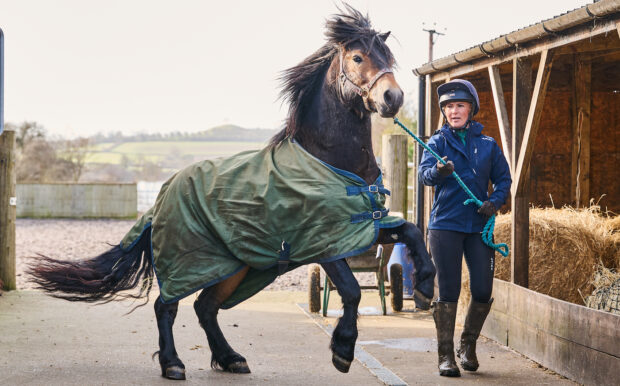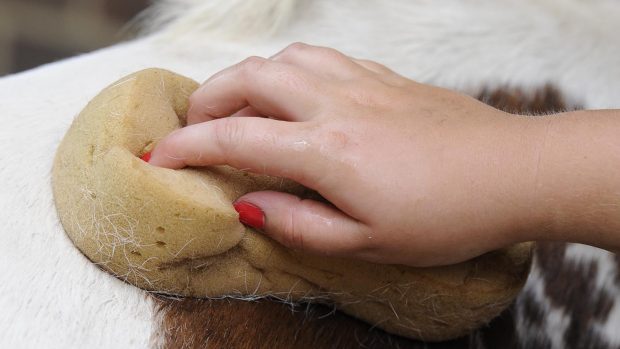It may not be as regular an occurrence as washing our own hair, but knowing how to bath a horse properly is a useful skill. An essential one, too, if you want him looking his gleaming best on the competition circuit. It’s also a handy time to examine your horse for any health conditions that may escape your attention during regular grooming.
Most horses don’t need regular bathing to keep their skin and coat healthy, so long as they are groomed well, with sweat rinsed off thoroughly and loose hair brushed out. In fact, over-shampooing, without sufficient rinsing, can cause dry skin and other related conditions. But a thorough bath is useful for show days, and when you really want to shift some of that dirt and show your horse off.
Ideally, wash your horse on a warm day and ensure you can dry them off sufficiently afterwards, whether it’s by walking them in the sun, with heat lamps or towel-drying. If you’re likely to be bathing throughout the winter, it might be worth investing in one of the best portable hot showers for horses.
How to bath a horse: step by step
First of all, gather your equipment: a rubber currycomb, sweat scraper, grooming brush, shampoo designed for horses, mane/tail detangler and conditioner, bucket of water, sponge, towel and hose.
Give your horse a thorough grooming before bathing to remove excess dirt and hair. You may want to give your horse a haynet to keep him occupied.
Start slowly – most horses are familiar with the hosepipe, but it should be introduced gradually from the hooves upwards. If this is the first time the horse has been bathed, it may be wise to do so without shampoo for the first time. This will make the experience shorter and will ensure you don’t leave irritating soap suds in if you have to stop halfway through the job.
Wet the horse thoroughly before applying shampoo as it is easier to use a soapy sponge on a wet coat. Add shampoo to the bucket of water as per the instructions on the bottle, then dip the sponge in the soapy water and rub it all over the horse’s coat using a circular motion.
A good way to make sure you cover the whole horse is to break it up into sections, such as legs, neck, body and quarters. Take extra care around the genitals and dock, using gentle strokes to wash these sensitive areas. Some owners prefer to rinse after each section is shampooed to prevent the soap from drying out the skin and coat, but many will work quickly and shampoo the whole body in one go, before rinsing.
This should be sufficient for most horses, but for greys and coloureds, extra help may be required to make their white coats dazzle.
Mane and tail washing
Wash the mane as you would the rest of the body, wetting it first and then applying shampoo with a sponge. If it is knotted, use detangler.
Leave the tail until last as you can use the remaining soapy water. Immerse the bottom of the tail in the bucket of soapy water, and swirl it around, using the sponge to wash the hair on the dock. Again, a detangler should sort out any knots and enable you to brush through it smoothly. You can also use a mane and tail conditioner on both to make them silky smooth.
Take care bathing the head
Most horses do not enjoy water pouring down the face, let alone the hose being sprayed near it – although there are always exceptions! Many owners avoid using any shampoo on the face, but this is up to personal opinion. Take care soapy water does not go in the eyes and any soap residue is completely rinsed off. For more sensitive horses, a thorough wipe with a wet towel should be sufficient.
Be careful not to get water in the horse’s ears. When you are washing the forelock, tug it backwards towards the mane, so that water doesn’t splash into the horse’s pricked ears.
Drying off
After the shampooing, rinse the horse thoroughly, ideally using a hose on a gentle stream. If he will not take the hose, you will need several buckets of clean water and clean sponges to get rid of all the soap residue. Then, use the sweat scraper to remove all the excess water in the direction of the hair growth.
The clean and rinsed horse should be thoroughly dried, ideally in the sunshine. You can also rub them dry with a towel, walk them around or stand them under heat lamps if you have them. If it is cool, put a cooler rug on to help speed up the drying time.
And be warned – nearly every horse enjoys a good roll even more than usual after a bath, so make sure you’ve poo picked and he is as dry as possible before leaving him, or you’ll be back to square one.
You might also be interested in:

Spa time: best portable hot showers for year-round bathing

20 shampoos that will get your horse sparkling – because he’s worth it!

14 dry shampoos and stain removers that will leave your horse gleaming

How to remove stable stains and keep a grey horse clean

The best mane and tail detanglers to keep your horse looking lustrous

Subscribe to Horse & Hound magazine today – and enjoy unlimited website access all year round
Horse & Hound magazine, out every Thursday, is packed with all the latest news and reports, as well as interviews, specials, nostalgia, vet and training advice. Find how you can enjoy the magazine delivered to your door every week, plus options to upgrade your subscription to access our online service that brings you breaking news and reports as well as other benefits.






